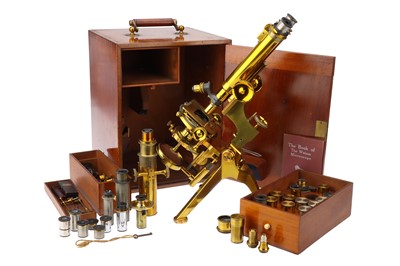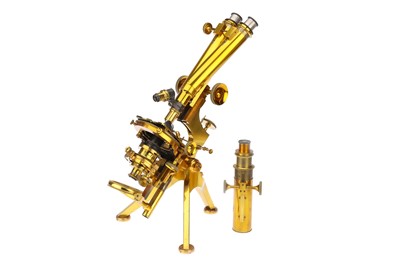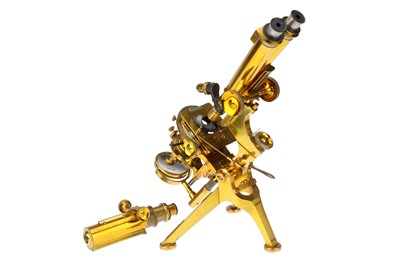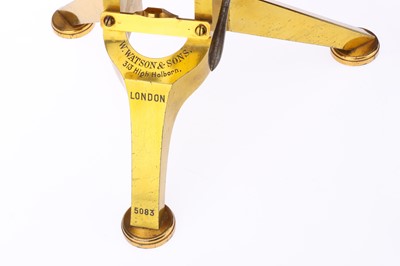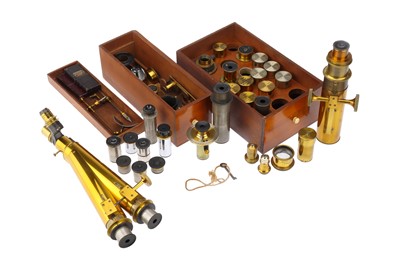24th May, 2023 12:00
Fine Instruments of Science, Medicine and Books
A Very Fine W. Watson & Sons Van Heurck Monocular & Binocular Exhibition Microscope
English, c.1900, engraved to the back of the tripod stand 'W. WATSON & SONS, 313 High Holborn, LONDON, 5083' the microscope on a massive lacquered brass tripod foot, with brass pad feet, at the top is a large friction locked trunnion that supports the main body of the microscope, at the bottom is a large plano-concave mirror in a gimbal, above this is the fully mechanical substage with X-Y control, rotational control via a gear and pinion, all with rack and pinion focusing, full mechanical circuit stage with Turrel type adjustment with vernier scales, limb incorporating fine focus control with course rack and pinion to the rear of the bodytube, the monocular body tube with a racked drawer tube and push/pull drawer tube, the binocular body with inter-ocular rackwork, in the original French polished mahogany cabinet with two drawers of accessories, the first containing:
A Pair of Zeiss binocular eyepieces,
6 Watson & Sons HOLOS objectives in cans,
A Watson & Sons 3in objective & can,
2 HOLOS oil condensers in cans,
3 eyepieces,
A substage condenser holder,
the second drawer contains:
A cased micrometer by Watson & Sons,
A cased Maltwood finder,
A side reflector,
A set of stage forceps,
2 substage polarisers,
A parabolic condenser,
An achromatic condenser,
A nosepiece analyser,
A brass case of stops,
The Watson-Van Heurck microscope is named after its two inventors, William Watson and Jean-Baptiste van Heurck the Belgian Diatomist. It was developed in the late 19th century and was considered one of the most advanced microscopes of its time.
William Watson was a British microscope maker who began working on the design of a high-quality microscope in the 1870s. He was motivated by a desire to improve the quality of microscopes used for scientific research and medical diagnosis. He worked on several designs before settling on the final one in collaboration with Jean-Baptiste van Heurck.
The Watson-Heurck microscope was designed to improve upon the limitations of existing microscopes. The optics had a good range of magnification and resolution, allowing for more detailed observations of specimens. It also had a more stable base, reducing vibrations and improving the clarity of the image.
One of the key features of the Watson-Heurck microscope was its use of a sub-stage condenser. This allowed for more even lighting of the specimen and reduced the distortion caused by uneven illumination.
The Watson-Heurck microscope was widely used in scientific research and medical diagnosis throughout the late 19th and early 20th centuries. It was particularly popular for studying diatoms, single-celled organisms with intricate, glass-like shells that are difficult to observe with standard microscopes.
The Van Heurck microscope was available in various models, but this, the 'Exhibition' stand, was the most expensive and was sold only as a special order microscope. Due to the cost of this microscope when new very few are found today with the binocular head, most are monocular.
The Watson-Heurck microscope remained popular until the mid-20th century when newer technologies, such as electron microscopes, became more widely available. However, it is still used today by some researchers and collectors of antique scientific instruments.
Overall, the Watson-Heurck microscope was a significant advancement in the field of microscopy and played an important role in scientific research and medical diagnosis during its time.
Sold for £6,875
Result plus buyers premium
English, c.1900, engraved to the back of the tripod stand 'W. WATSON & SONS, 313 High Holborn, LONDON, 5083' the microscope on a massive lacquered brass tripod foot, with brass pad feet, at the top is a large friction locked trunnion that supports the main body of the microscope, at the bottom is a large plano-concave mirror in a gimbal, above this is the fully mechanical substage with X-Y control, rotational control via a gear and pinion, all with rack and pinion focusing, full mechanical circuit stage with Turrel type adjustment with vernier scales, limb incorporating fine focus control with course rack and pinion to the rear of the bodytube, the monocular body tube with a racked drawer tube and push/pull drawer tube, the binocular body with inter-ocular rackwork, in the original French polished mahogany cabinet with two drawers of accessories, the first containing:
A Pair of Zeiss binocular eyepieces,
6 Watson & Sons HOLOS objectives in cans,
A Watson & Sons 3in objective & can,
2 HOLOS oil condensers in cans,
3 eyepieces,
A substage condenser holder,
the second drawer contains:
A cased micrometer by Watson & Sons,
A cased Maltwood finder,
A side reflector,
A set of stage forceps,
2 substage polarisers,
A parabolic condenser,
An achromatic condenser,
A nosepiece analyser,
A brass case of stops,
The Watson-Van Heurck microscope is named after its two inventors, William Watson and Jean-Baptiste van Heurck the Belgian Diatomist. It was developed in the late 19th century and was considered one of the most advanced microscopes of its time.
William Watson was a British microscope maker who began working on the design of a high-quality microscope in the 1870s. He was motivated by a desire to improve the quality of microscopes used for scientific research and medical diagnosis. He worked on several designs before settling on the final one in collaboration with Jean-Baptiste van Heurck.
The Watson-Heurck microscope was designed to improve upon the limitations of existing microscopes. The optics had a good range of magnification and resolution, allowing for more detailed observations of specimens. It also had a more stable base, reducing vibrations and improving the clarity of the image.
One of the key features of the Watson-Heurck microscope was its use of a sub-stage condenser. This allowed for more even lighting of the specimen and reduced the distortion caused by uneven illumination.
The Watson-Heurck microscope was widely used in scientific research and medical diagnosis throughout the late 19th and early 20th centuries. It was particularly popular for studying diatoms, single-celled organisms with intricate, glass-like shells that are difficult to observe with standard microscopes.
The Van Heurck microscope was available in various models, but this, the 'Exhibition' stand, was the most expensive and was sold only as a special order microscope. Due to the cost of this microscope when new very few are found today with the binocular head, most are monocular.
The Watson-Heurck microscope remained popular until the mid-20th century when newer technologies, such as electron microscopes, became more widely available. However, it is still used today by some researchers and collectors of antique scientific instruments.
Overall, the Watson-Heurck microscope was a significant advancement in the field of microscopy and played an important role in scientific research and medical diagnosis during its time.

